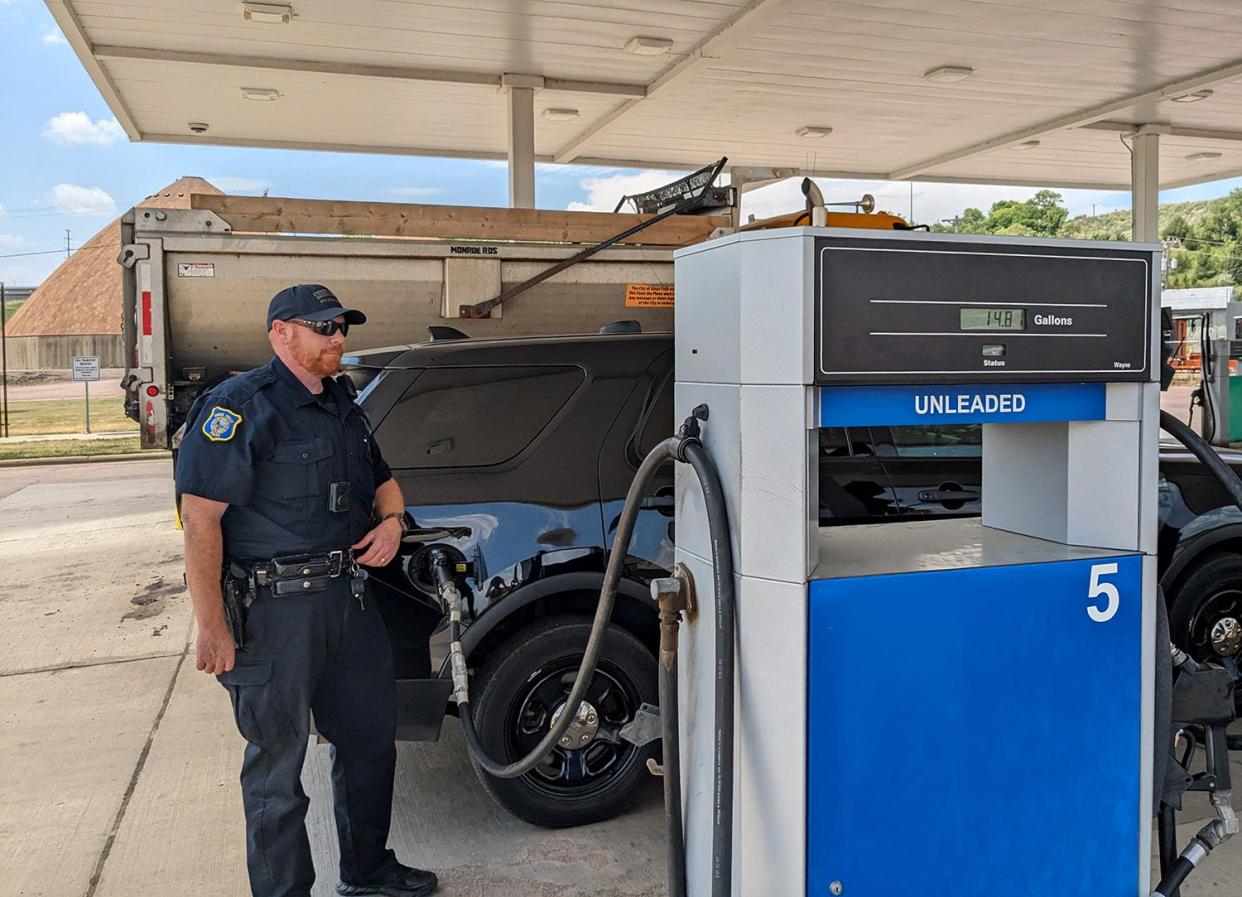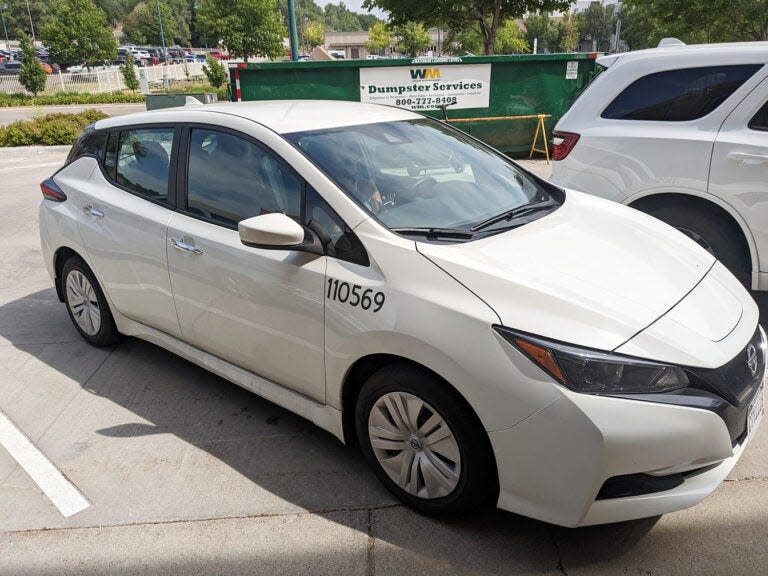Supply chain struggles complicate Sioux Falls’ transition to electric vehicles

Morgan Jackson would love to get a few more gas-electric hybrids for the Sioux Falls Police Department.
The SFPD’s four hybrids are 25-37% cheaper to fuel than the rest of the fleet. That’s no small savings for police cruisers, which average 30,000 miles a year. Non-hybrids burn up an average of $43,000 a month in fuel.
That’s why the city was set to buy more hybrids in 2022, and even publicized its intent to do so.
But Jackson, the city’s fleet manager, wasn’t able to land a single one.
“Ford’s having supply chain problems right now.” Jackson said.
Jackson’s not alone.
Two of the Minnesota cities Jackson looked to for information about electric fleet vehicles in recent years have also struggled with wait time, although those cities hope to step beyond gas-electric hybrids and toward fully electric options.
Wait times for all fleet vehicles have grown in recent years through supply chain struggles and a shortage of computer chips. The issue can be compounded with electric vehicles. They typically cost more to buy, but can save taxpayers money long-term in fuel and maintenance as they help cities with carbon footprint reduction goals meet their targets.
For taxpayer-funded operations, there are plenty of issues with electric vehicles beyond wait times.
Fleet managers like Jackson in cities across the Upper Midwest have concerns about the availability of charging stations and the cost to install them for city vehicles, as well as about vehicle performance and battery life in cold temperatures.
Even after clearing those hurdles, the prospect of electric transition hinges as much on availability as willingness. If the price is too high and the wait time is too long, municipal fleets can’t take advantage.
“We’re chomping at the bit to get them, but we’re going to wait to make sure it’s cost effective for us,” said Dan Solheid, fleet manager for the city of Woodbury, Minnesota.

Cost, performance considerations
Woodbury was among the cities Sioux Falls contacted before purchasing its first all-electric vehicle in December, a Nissan Leaf for the Health Department.
A news release from the city said the pilot program would serve to test the fuel efficiency and durability of the $32,651 sedan, as compared to vehicles of similar sizes.
It’s too early to come to any conclusions on the Leaf, Jackson said, but there is at least one encouraging sign: It’s cost the city $8 to fuel for its first 663 miles on the road.
“That would have been $72 in gas,” Jackson said.
The Health Department was a good place to start, Jackson said, since department employees don’t drive as many miles as other city employees and don’t need to haul heavy equipment.
Bloomington, Minnesota, bought two Nissan Leafs in 2019. They’re used by restaurant inspectors, who rarely drive more than 50 miles a day, according to fleet manager Michael Keim.
Lower fuel costs have been a benefit, Keim said, but there are other savings. Electric vehicles have simpler engines with just a few dozen parts total. Internal combustion engines, by comparison, have around 200.
Tires are the primary maintenance concern for EVs, Keim said, as tires wear out regardless of the engine type.
“There are still maintenance items, but it’s a lot less maintenance. No oil changes, no tune-ups, no drive belts,” Keim said. “It’s just a lot less complexity.”
The upfront cost was higher for the EVs, Keim said, but they cost 24 cents a mile to power, versus 45 cents for a traditional vehicle. The break-even point for cost will come at around 35,000 miles, Keim said.
Black Hills State University has an all-electric Chevrolet Bolt for its professors to use on trips between campuses in Rapid City and Spearfish. It also installed charging stations at each campus to allow for charging between classes, and the stations are available for anyone else in their respective communities.
The pilot has been a success thus far, said Debbie Liddick, BHSU’s assistant director of facilities and sustainability.
“We save about 260 gallons of gas a year by driving this vehicle,” Liddick said.
The Bolt, which is painted with BHSU colors, is also helping the university advertise its presence as it hits sustainability targets. The EV reduces the university’s carbon footprint by 2.5 tons of carbon dioxide every year.
“An average family produces 5.7 tons of CO2 a year,” Liddick said. “It’s saving quite a bit.”
Options for electric fleets
There are three categories of electric vehicles on the market in the U.S.:
Gas-electric hybrids: Vehicles with gas-powered and electric engines. Batteries charge when traveling down hills, and the electric power supplements the gasoline engine. They cannot be plugged in.
Plug-in hybrids: Vehicles with gas-powered engines that only kick on when the on-board battery power runs out. The batteries are charged by plugging in, as well as while going downhill.
All electric: Vehicles without an internal combustion engine. The batteries can be charged slowly with a typical household outlet, but more quickly at rapid charging stations.
Sioux Falls and BHSU aren’t the only taxpayer-funded operations in South Dakota with one or more of them. Brookings has used a plug-in hybrid SUV for two years, with employees of various departments taking turns behind the wheel. Aberdeen’s police department, like its counterpart in Sioux Falls, has folded gas-electric hybrids into its fleet, and the cost savings helped the department cope with high fuel prices last summer.
There are limits to what each type of vehicle can do, though. Most all-electric vehicles lose significant range in the winter or summer months through heater or air conditioner use. Smaller models like a Leaf or Bolt don’t have the space for the kind of equipment home inspectors or parks and recreation employees need to haul from site to site.
Police vehicles, which usually stay running all through a patrol officer’s shift, have even more specific needs. Chevrolet recently announced its first police pursuit-rated electric vehicle, the 2024 Chevy Blazer, and Ford offered a police-grade version of its F-150 Lightning in 2023.
Solheid, the fleet manager for Woodbury, said the lack of pursuit-rated EVs – as well as the higher upfront cost – has been a holdup for his city’s police department.
“I won’t put any patrol officer into a vehicle that isn’t a police pursuit-rated vehicle, from the drive train to the brakes to the suspension,” Solheid said.
In the interim between all-electric and all-gas, Woodbury has opted for plug-in Mitsubishi Outlander hybrids for use across various departments. They can travel 35-40 miles on battery power before the gas engine kicks in, though it will also kick in occasionally to keep the fuel in the tank from going bad.
Woodbury recently added charging stations with the help of Xcel Energy for its plug-ins, in part to get a better sense of how much electricity it takes to run them. The utility paid for the stations, Solheid said, in exchange for a $300 annual fee per vehicle and a data sharing agreement.
That data will help Solheid to determine how much the vehicles actually save – something he can’t easily quantify for his city’s chosen electric option.
“They’ll show that they’re getting 45 to 65 miles to the gallon, but we don’t have a good calculator on how much the electric is costing us,” he said.
The charging stations are also to get employees used to driving electric.
“Plug-in hybrids do a great job getting staff acclimated to plugging in and getting over all those range anxiety issues,” he said. “We haven’t had anyone drive off with the cord plugged in yet, so that’s good.”
Wait times, future needs
Woodbury was ready to go a step further with all-electric vehicles, but struggled with wait times for Ford F-150 Lightning pickups last year. Solheid then looked into electric Chevrolet Silverado pickups, but the prices for the fleet version of that model were too high.
Bloomington ordered eight F-150 Lightnings for its home inspection and engineering crews last year, Keim said, but there’s about a year-long wait for them.
Keim has steered clear of plug-in hybrids, in part because they have some of the same maintenance costs of a gasoline vehicle, but not all the benefits. Unlike gas-electric hybrids or gasoline-powered cars, they can’t take advantage of waste heat from the engine to keep city employees comfortable while idling in the cold.
“With the style of driving that they do, they wouldn’t build up the heat in the wintertime when they needed to warm up the cab,” Keim said.
Keim and Solheid also talked about the importance of faster charging stations as a preparation for the future, but tearing up the ground beneath and laying cable can be a significant expense. Bloomington paid $15,000 to install two chargers, but will partner with Xcel – similar to Woodbury – for its next set of fast chargers.
Solheid hopes the industry continues to explore charging options for municipal fleets, especially for employees who might travel far afield from the city garage. A company called Beam offers mobile solar arrays for charging on the go, for example, but that technology is too expensive for his city at this point.
The Woodbury fleet manager also sees potential in hydrogen vehicles, particularly for larger vehicles like snowplows, and thinks a mix of fuel sources is inevitable as the nation transitions to lower-carbon fuel sources.
“Don’t rule out hydrogen,” Solheid said. “Hydrogen fuel cells are an up-and-coming thing. And you know, the only byproduct of that is water.”
Factors like charging station costs, energy costs and basic utility from department to department will likely come into play in South Dakota, as well.
Jackson said Sioux Falls will always do its homework and crunch numbers before it moves toward renewable transportation options. The police department hybrids have proven their worth, he said, even though the wait times put them out of reach.
As for the next steps, Jackson expects to listen and learn from other cities and crunch the numbers before moving forward.
In the end, he said, dollars and cents will be the guide.
“I’m a big proponent of making sure we’re being fiscally thrifty with our taxpayer money,” Morgan said.
This article originally appeared on Sioux Falls Argus Leader: Supply chain struggles complicate cities’ transition to electric vehicles

